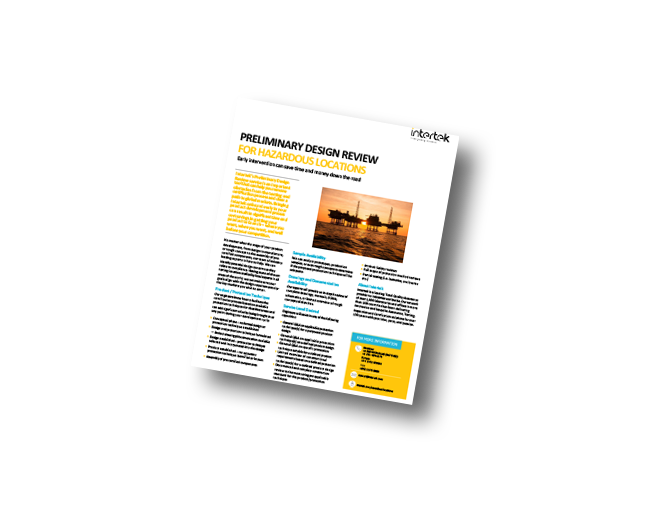Get a head start on your plan for market success with a Preliminary Design Review
What is a Preliminary Design Review for Hazardous Locations?
A Preliminary Design Review (PDR) for Hazardous Locations is a critical step in the development and evaluation of equipment or systems intended for use in environments where flammable gases, vapors, dust, or other hazardous substances are present. Hazardous locations, also known as explosive atmospheres, are areas where the concentration of these substances can potentially lead to explosions or fires if proper precautions are not taken.
The PDR for Hazardous Locations is a formal review process typically undertaken during the early stages of a project or product development. Its primary purpose is to assess and validate the design of equipment or systems to ensure they meet the necessary safety standards and requirements for use in hazardous environments.
Key aspects of a Preliminary Design Review
- Documentation Review: Design documentation is reviewed, including specifications, drawings, schematics, and any relevant calculations. They verify that the design aligns with applicable safety standards, codes, and regulations.
- Risk Assessment: Hazardous locations pose inherent risks, and the PDR evaluates how well the design addresses these risks. This includes assessing the potential for ignition sources and the effectiveness of measures to prevent explosions or fires.
- Compliance with Standards: The design is compared against specific industry standards and regulations, such as those set by organizations like the National Fire Protection Association (NFPA), the International Electrotechnical Commission (IEC), or other relevant standards.
- Operational Requirements: The review assesses whether the equipment or system meets the operational needs of the intended application within the hazardous location. This includes evaluating factors like temperature, pressure, and compatibility with the hazardous substances present.
- Safety Features: The PDR examines the inclusion of safety features and mitigation strategies, such as explosion-proof enclosures, electrical isolation, and grounding, to prevent or minimize the impact of potential hazards.
- Environmental Considerations: Environmental factors, such as temperature ranges and humidity levels in the hazardous location, are considered to ensure that the equipment can operate reliably under these conditions.
- Documentation of Findings: The results of the PDR are documented in a formal report, highlighting any deficiencies or areas requiring further attention. Recommendations for design modifications or improvements may be included.
Our Preliminary Design Review (PDR) for Hazardous Locations is designed to address compliance issues, streamline your development process, and expedite your entry into target markets.
The outcome of a successful Preliminary Design Review is a design that is well-prepared to move forward into more detailed design phases, prototyping, testing, and eventual production. It provides confidence that the equipment or system will meet safety and regulatory requirements when deployed in hazardous locations, reducing the risk of accidents, fires, or explosions.
You can customize your preliminary design review through Intertek to include:
- General Questions and Answer
- Navigating the protection methods
- Drawing, Documentation or Construction reviews
- Review of sample and prototype requirements
Below is an image of battery testing in our hazardous Locations laboratories:
Battery requirements are often discussed as part of the Preliminary Design Review process.
Knowledge Center
Updates to the Canadian Electrical Code (CEC) Section 18
Preliminary Design Review for Hazardous Locations
Guide to Hazardous Location Equipment Marking
Hazardous Locations & Explosive Atmospheres Equipment Certification Requirements Webinar Series
Guide to Equipment Certification Requirements for Hazardous Locations Poster
UAE ECASEx: Unit Verification Webinar
IEC 60079-25 for Intrinsically Safe Electrical Systems: Edition 3
Product Listing & Marking Strategies
8 Ways to Expedite Intrinsically Safe Product Certification Process
For more expert resources, recordings, and presentations, visit our Hazardous Locations Resources Hub.

Events
North America: Year-round CompEx Course Schedule
Intertek Chester UK facility including CompEx course modules and descriptions
Resources
- Client Testimonials
- ETL Mark The Industry's Fastest Certification Program
- Functional Safety Services
- Field Evaluation
- On-site Design Review
- Certification Program for Industrial Control Panels (ICP)
- EMC Testing

